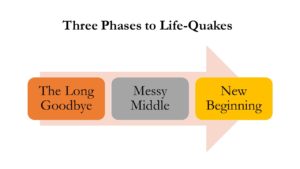By Rose O. Sherman, EdD, RN, NEA-BC, FAAN
Over the past six months, I have presented webinars for nurse leaders across the country on the topic of thriving after a lifequake. An interesting takeaway from these sessions has been that healthcare leaders want to resume business as usual, but many nurses are not ready to do that yet. Nurses are still coming to grips with the reality that the future will not be like the past. They are rethinking everything about their careers and work.
None of this is unusual during a lifequake experience. Bruce Feiler, an expert on these major life transitions, tells us that we go through three phases. The first phase is called the long goodbye when we are stuck in grief over what we have lost and battle new changes we may not want.
The second phase is what Feiler describes as the messy middle. This messy middle can last for an extended time, and it is hard. During this phase, we shed habits, routines, and beliefs that no longer work for us. During this messy middle, we need to heal and be reflective about what we want next in our lives. The final phase is a new beginning that we move into after these major transition experiences. Life then becomes the new normal.
The tension in many health systems right now is that there is enormous pressure, especially from senior leaders to move quickly into the new beginning. Patient volumes have increased significantly throughout most of the country. There is financial pressure to get back on track. At the same time, many nurses are still in the messy middle of the lifequake experience asking themselves – what just happened here? This disconnect is leading to resignations, staffing shortages, and increased unionization in some settings as nurses respond to what they see as a lack of concern for what they have been through.
Many nurse leaders tell me that they are advising their leadership teams to put a pause on any new initiatives that can be postponed. While nurse leaders understand the need to move into the new normal, they also recognize that many of their nurses are burned-out, exhausted, and not yet ready to forge ahead into new things. Leaders are often much more resilient than their staff – they have to be if they want to survive and thrive in leadership. It is important when leading to take time to look back to see how far behind others may be. You may sometimes be surprised to see how wide that gap can be.
Reference
Feiler B. Life is in the transitions: Mastering change at any age. New York: Penguin Press; 2020.
© emergingrnleader.com 2021
BRAND NEW WEBINAR Flyer Become the Boss No One Wants to Leave Nurse Retention in Turbulent Times
Give your leadership team the gift of a highly rated webinar – Nursing Leadership in 2021: Rebooting after a Life-Quake A Nursing Leadership Reboot Workshop.
Read the Nurse Leader Coach – Available at Amazon and Other Book Sellers.
Now Available to Strengthen Your Leadership in 2021 – The Nuts and Bolts of Nursing Leadership: Your Toolkit for Success




 LinkedIn
LinkedIn Instagram
Instagram